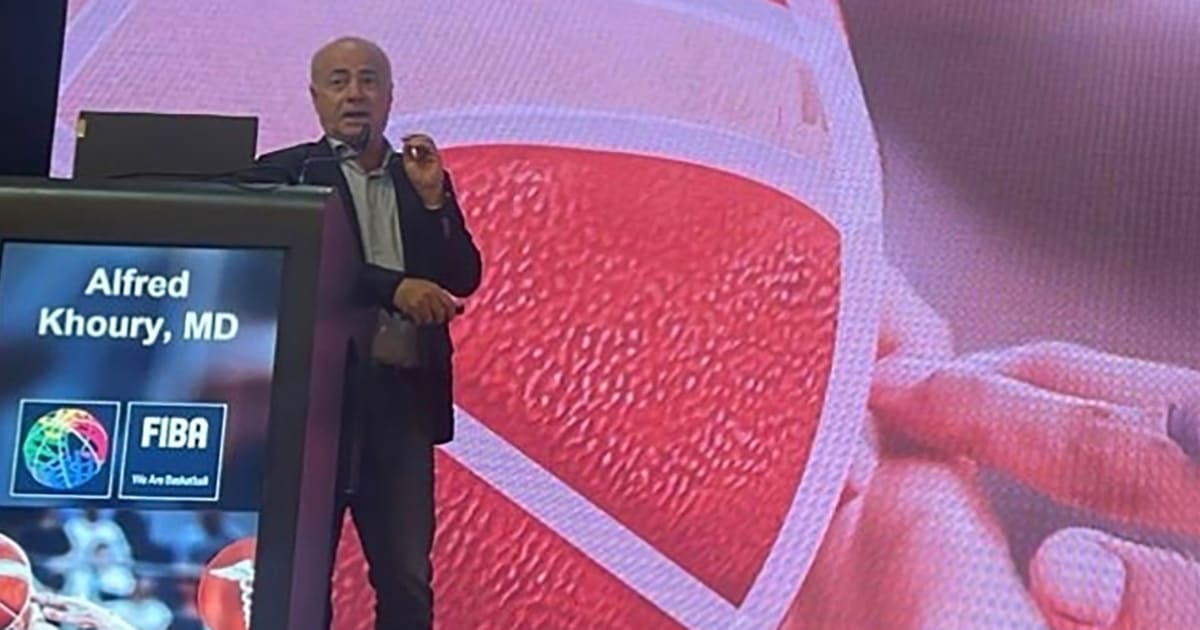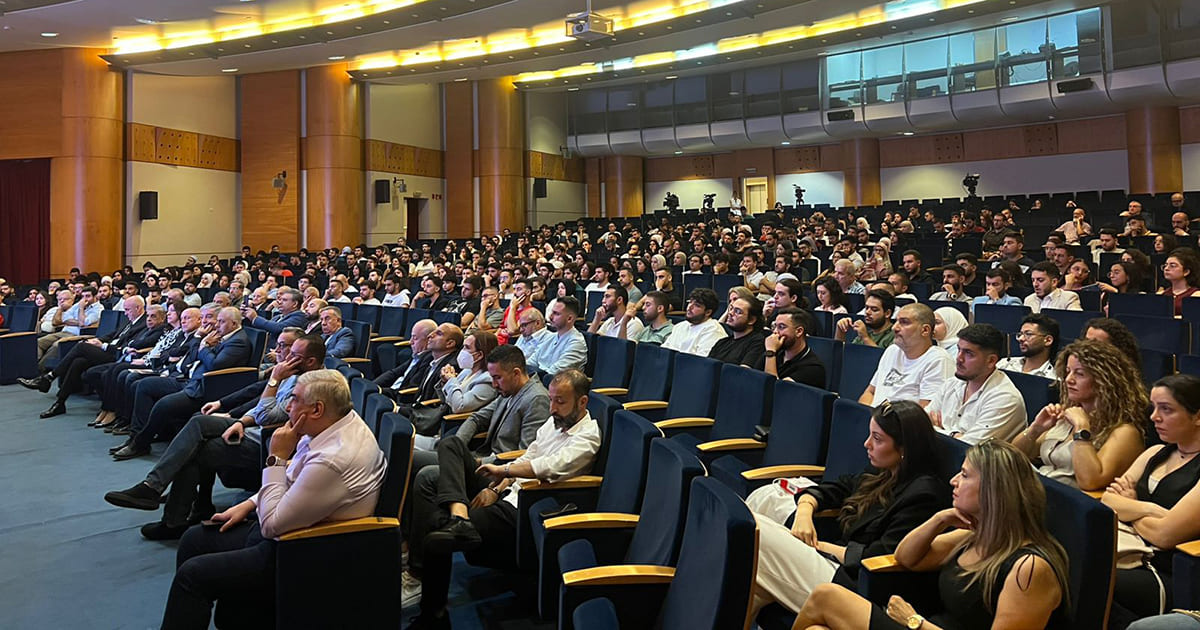LAU Physicians Set National Benchmark for Sports Health
Specialized doctors in cardiology, infectious diseases, orthopedics, and ophthalmology offered their expertise at Asia’s first FIBA Health & Performance Seminar.
On any basketball court, a sudden injury can determine the outcome of a game or affect the long-term health of an athlete. Ensuring that players perform at their peak while staying safe requires more than skill and training; it demands a comprehensive medical framework, proactive prevention, and collaboration across multiple disciplines.
This integrated approach formed the core of the FIBA Health & Performance Seminar, held on June 25, 2025, at the Lebanese Order of Physicians, where LAU’s medical faculty joined sports scientists, medical professionals, and industry experts to explore key issues at the intersection of sports and health and ensure athletes’ wellbeing.
Cardiovascular risk remains one of the most serious threats to athletes, where even seemingly healthy players can face sudden cardiac events. Regular screenings are imperative for detecting critical conditions, as are timely follow-ups and a culture of prevention, noted Clinical Assistant Professor of Cardiology at the LAU Gilbert and Rose-Marie Chagoury School of Medicine and member of the Lebanese Basketball Federation’s Medical Committee, Emile Mehanna, during the seminar.
He recommended assessments before an athlete’s first competitive season, every two to four years depending on risk, and before returning after a significant illness. “Immediate access to Automated External Defibrillators (AEDs) and clear emergency action plans can make the difference between life and death on the court,” he said, stressing that personalized exercise plans, medical management, and Implantable Cardioverter-Defibrillators (ICDs) for high-risk players are essential.
Return-to-play decisions, he added, should consider disease resolution, functional testing, gradual reintegration, and psychological support, reinforcing FIBA’s call for structured national screening, uniform protocols, and education for players, coaches, and medical staff.

Structured programs that integrate sleep, hydration, nutrition, and inflammation control are as critical as treatment itself, explained Clinical Assistant Professor of Orthopedic Surgery and Trauma at the LAU school of medicine and President of the Lebanese Basketball Federation’s Medical Committee Alfred Khoury.
“Players often underestimate how much poor sleep or improper meals can undermine training. Science shows these factors are as decisive as any medical treatment,” he said. Recovery modalities such as cold immersion, compression therapy, and mobility work were highlighted for their ability to counteract training fatigue.
The impact of international competition, Dr. Khoury noted, is often shaped by long-haul flights and time-zone changes that sap player readiness. Consensus-based strategies—such as adjusting sleep on flights, regulating light exposure, and timing meals—can help minimize jet lag. “Arriving prepared rather than drained is itself a competitive advantage,” he said, underscoring the practical link between science and schedule.
Preparation also begins before the season starts. In Lebanon, formal pre-season programs have been proven to reduce strains and prevent on-court injuries. Rehabilitation, too, requires a player-centered approach, Dr. Khoury argued. “Even reintroducing controlled load earlier in the process, when guided by symptoms, can speed up recovery,” he explained, urging teams to embed such individualized practices in structured recovery schedules.
Such attention to detail is not just medical but ethical. For Dr. Khoury, safeguarding athletes also means ensuring confidentiality and integrity. Doping control and medical privacy, he warned, must remain the sole responsibility of qualified physicians. “Athletes trust us with both their performance and their privacy. Safeguarding both is non-negotiable.”
Yet physical injuries are not the only threats to readiness—infectious diseases can be just as disruptive, especially in team sports due to close contact, shared facilities, and frequent travel, explained LAU Clinical Professor and Interim Chair of the Department of Internal Medicine Rula Husni Samaha.
Moderate, regular exercise strengthens immunity, but intense exertion without adequate recovery can suppress it. Even minor infections can derail performance by draining energy, disrupting sleep, and reducing concentration. “Athletes with active infections should be excluded from play until they are no longer contagious, with return-to-play tailored to the illness,” she said.
Behind each type of infection lies a specific protocol. Skin conditions such as MRSA (methicillin-resistant staphylococcus aureus) or impetigo require lesions to be dry, crusted, and covered before return. Viral infections like herpes demand at least 120 hours of antiviral treatment with no new lesions for 72 hours. Respiratory illnesses—including influenza, COVID-19, and strep throat—necessitate exclusion until fever-free for at least 24 hours without medication, while gastrointestinal illnesses require a 24 to 48-hour symptom-free period.
Dr. Husni emphasized that vaccination, hygiene, clean facilities, and swift isolation during outbreaks are indispensable. “Prevention is not just about injuries,” she stressed. “Protecting against infectious diseases is just as critical to keeping athletes safe and competitive.”
While infections silently undermine performance, trauma can strike in an instant—most commonly affecting vision. Sports-related eye injuries, though often overlooked, can alter careers if untreated. Assistant Professor of Clinical Medicine and ophthalmologist at the LAU Medical Center–Rizk Hospital Ibrahim Dunya underscored the importance of prevention, rapid diagnosis, and timely intervention in safeguarding vision.
As a FIBA Medical Commission member, Dr. Dunya described the event as a personal milestone. “This seminar represents a dream come true for me—a powerful collaboration between FIBA and the medical community, bringing together the best of the best: top-notch coaches, elite players, and world-class doctors, all under one roof,” he said.
Having competed at the highest levels of basketball and trained at the highest levels of medical education, Dr. Dunya reflected on his belief that progress lies at the intersection of sport and science. “With this event, our goal is to spark lasting impact—where athlete health is at the forefront and every professional involved in the game is equipped to protect, support, and elevate performance at the highest standard.”
Participants also explored a wide range of critical topics, including managing acute shock in basketball players, understanding brain concussions, bridging strength and conditioning with game performance, anti-doping considerations, and mental health in sports.
